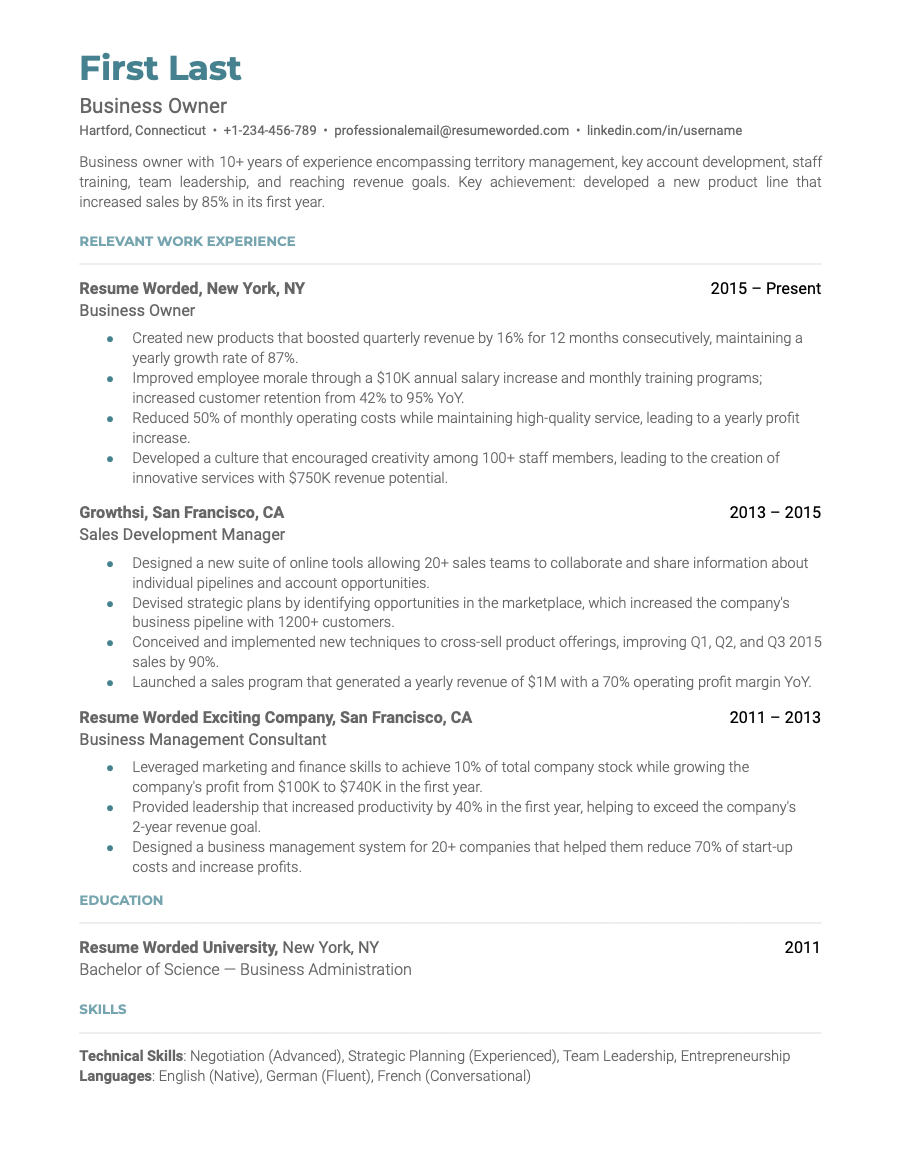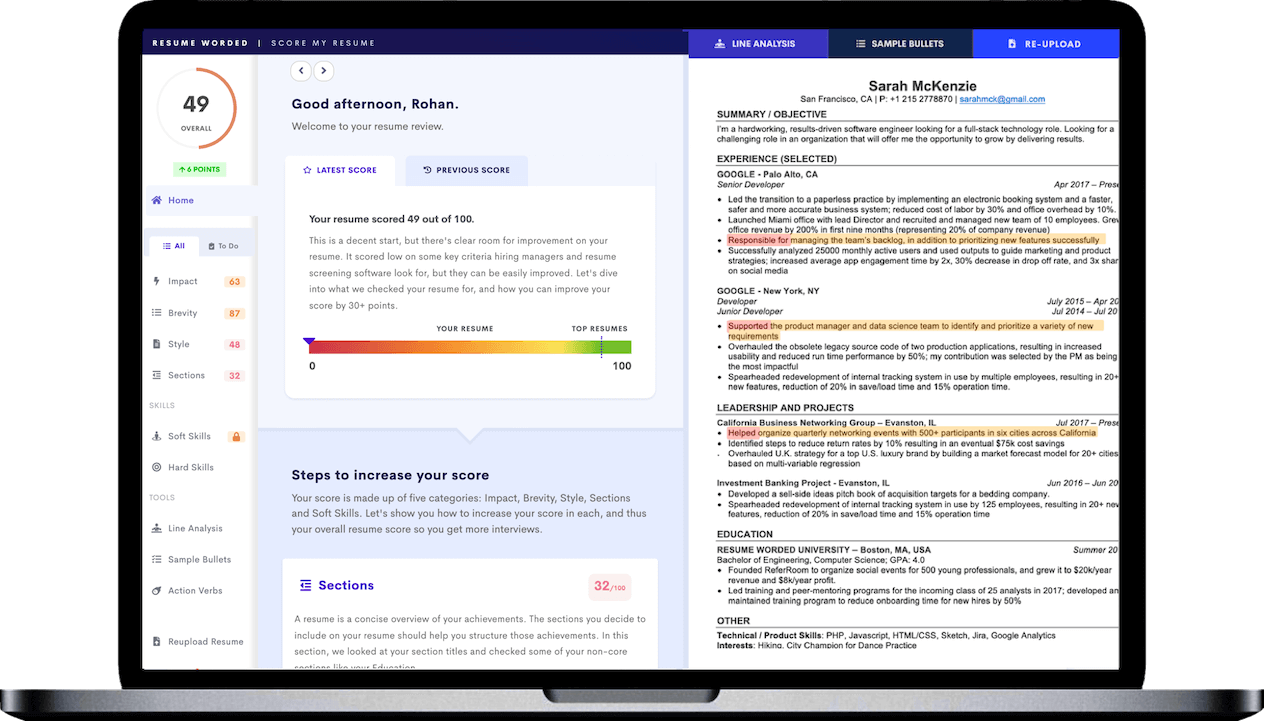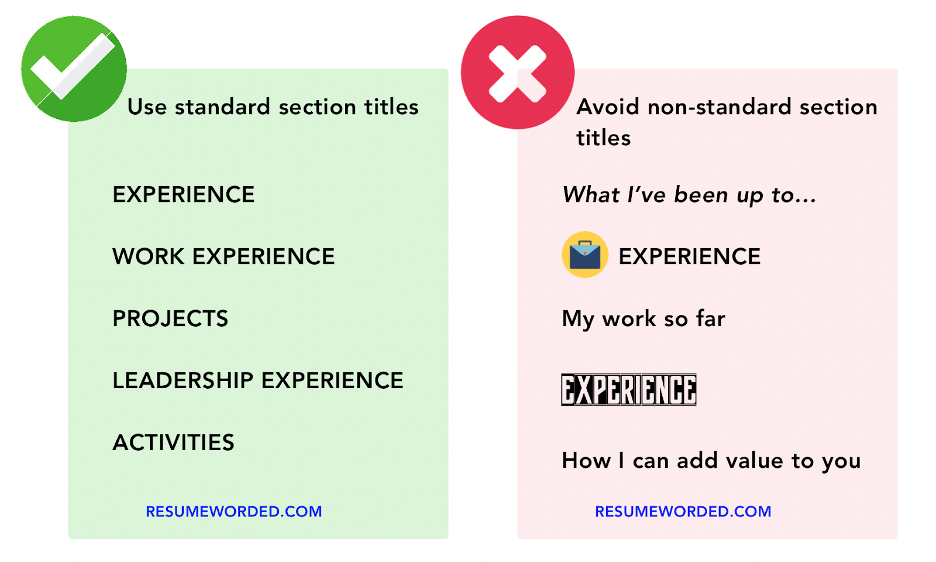If you own your own business, chances are you may not have updated your resume in a while. But if you’re thinking about transitioning into a different role — or even just seeing what else is out there — having a strong resume is the first step.
But how well does business ownership translate to a resume? What skills and accomplishments should you highlight? And what if you’ve been out of the traditional workforce for so long that you’ve nearly forgotten how it all works?
We’ll answer all those questions and more, but first, here’s a quick-start guide to listing small business ownership on your resume.
How to describe being a business owner on a resume
- The first thing you need is a company name. If you’ve been operating under your own name, it’s fine to stick with that — for example, “Jane Smith Consulting.”
- List your company as the employer and give yourself a job title that fits.
- Write a short blurb (1-2 sentences) that describes what the business was or what your role entailed.
- Include 3-6 bullet points highlighting key accomplishments in your role as the business owner.
- Quantify your accomplishments with hard metrics.
- List relevant hard skills in a separate Skills or Additional Information section.
Here’s an example:
WORK EXPERIENCE
Owner
John’s Gourmet Burgers, 2015-2025
Spearheaded expansion from a single location to a regional chain, increasing annual revenue from $500,000 to $2 million.
Essential skills for your entrepreneur resume
Skip the soft skills in your Skills section — you should focus on hard skills here instead. For entrepreneurs, these likely include:
- Data analysis
- Digital marketing
- Financial management
- Project management software
- Sales software
- Coding and programming
- Graphic design
- Foreign languages
What about transferable skills like leadership and communication? These belong in your accomplishments — for every soft skill you want to emphasize, think of a time when you used it at work and talk about that.
If you want to find out if your small business owner resume effectively showcases your transferable skills and accomplishments, upload it to the tool below — it’ll let you know if you’ve emphasized these relevant skills and achievements.
Accomplishments to highlight on a small business owner resume (with examples)
The most important thing to remember when writing resume bullet points as a business owner is to quantify your accomplishments. Since potential clients or employers can’t contact your manager for a reference, the more specific your accomplishments are, the more likely recruiters are to take them at face value.
Here are some metrics you should consider highlighting as a small business owner:
- Business growth
- Efficiency improvements
- Customer satisfaction
- Staff development
- Marketing successes
- Cost reduction
And here are some examples to illustrate how to do exactly that.
Business growth
As a business owner, you had to take responsibility for the company’s bottom line. Use this to your advantage by including accomplishments that prove you can make an impact on business growth.
For example:
Expanded the business from one to four locations within three years, increasing overall company revenue by 220%.
Cost reduction
What’s just as good as making money? Avoiding spending it in the first place! If you reduced your small business costs, be specific about how you did it — and how much you saved.
For example:
Negotiated better terms with suppliers, reducing costs by 15%.
Efficiency improvements
Time is money, which means that accomplishments related to saving time or improving efficiency belong on your resume just as much as ones with dollar signs.
For example:
Automated key administrative processes, resulting in a time saving of 15 hours per week.
Customer satisfaction
Most small businesses rely on customer satisfaction — but so do larger ones, which makes it an ideal entry for your resume.
For example:
Maintained an average customer satisfaction rate of 95% over five years, according to annual surveys.
Staff development
Training others is a valuable skill in just about every role and industry. If you trained or managed employees other than yourself, make room for those accomplishments on your resume.
For example:
Developed a training program for employees that reduced turnover rate by 20%.
Marketing successes
Successful marketing shows initiative, communication, and business savvy. Even if you’re not applying for marketing roles, you should find a place to talk about those successes on your resume.
For example:
Negotiated a co-marketing partnership with a complementary business, leading to a 20% increase in customer referrals.
How to list your own business on a resume: Sample template
Here’s a sample resume for a self-employed business owner.

You can download this resume — and others — from our selection of Business Owner resume templates.
Common mistakes to avoid when writing a small business owner resume
Now that we’ve seen some examples of what to do when writing a resume as a business owner, let’s discuss what not to do.
Overemphasizing the "Owner" title
Running your own business is an impressive accomplishment — but not one that you should put a lot of weight on in and of itself. If you put too much emphasis on being the owner, it may make hiring managers wonder how you’ll fit into a corporate structure where you’re not the one in charge.
Avoid this by: Including examples of accomplishments that show your ability to work as part of a team and under supervision.
Not explaining why you're going from owner to employee
If you have “Business Owner” somewhere on your resume, most recruiters are going to wonder why you’re giving that up to go back to traditional employment. Did you buckle under pressure? Did the business fail? Were your skills not quite up to par?
Avoid this by: Addressing any potential concerns upfront in your cover letter or a brief resume summary. Whatever the reason, try to put a positive spin on it — for example, you could say that you're seeking new challenges or that you want to build on your skills in a larger organization.
Leaving off a failed business
No business owner in history has ever completely avoided failure. While it might be tempting to take a failed business off your resume, it’s better to leave it on.
Avoid this by: Focusing on what the experience taught you and how it has made you a better entrepreneur — after all, we learn more from our failures than from our successes.
Assuming everyone understands your business
Not everybody is going to understand the ins and outs of business ownership. The more niche your industry, product, or service, the less likely it is that potential employers will understand its intricacies.
Avoid this by: Including a short blurb underneath your company name and job title that explains in everyday terms what you (and your business) did. And avoid all jargon, even if it seems common to you — use plain language instead.
Failing to show your range of skills
As a business owner, chances are you’ve worn a lot of hats, from marketing and sales to HR and finance. Don’t let this go to waste — it’s okay to toot your own horn on your resume!
Avoid this by: Making a list of your skills, both hard and soft. List hard skills in your Skills section and soft skills in your Work Experience bullet points.
If you’re not sure which hard skills to include in your skills section, use the tool below to search for the job you’re applying for. It’ll give you a list of relevant hard skills.
Including every single task and accomplishment
On the other hand, it’s also possible to go too broad with your resume. Remember that your resume isn’t an autobiography – it’s a marketing document.
Avoid this by: Tailoring your resume to the specific job you’re applying for. You may end up with multiple (maybe even very different) versions of your resume for different roles or industries — lean into it.










